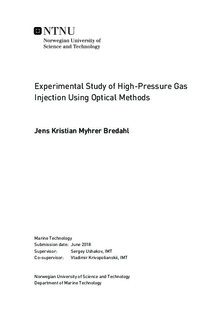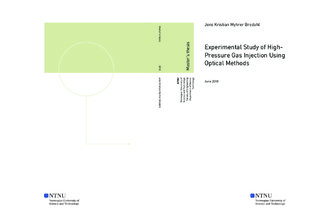| dc.description.abstract | This thesis first presents the role of LNG as a potential means to reduce marine emissions and get international shipping into compliance with new regulations set by regulatory authorities. An overview of different gas engine concepts with their merits and limitations is also presented.
An experimental study have been conducted at SINTEF Ocean's engine laboratory in order to determine the operational profile of a prototype gas injector. Special focus was put on determining the injector discharge coefficient and macroscopic gas jet characteristics. Experiments with both steady state flow conditions and dynamic rapid burst injections were performed for a wide range of injection pressures. Five different injector nozzles, three circular nozzles with diameters of 1.48mm, 2.04mm and 2.88mm, and two specially designed non-circular nozzles were used. This allowed for the study of the effect of nozzle geometry on the injection. The optical techniques Schlieren and Background-Oriented Schlieren were used to study the injection of high-pressure gas into a constant volume combustion chamber. For these experiments the injection pressures used was 381bar and 218 bar. For half of the tests the chamber pressure was atmospheric, for the other half the chamber was pressurized to 20 bar using nitrogen.
The results from the steady-state experiments show that the larger nozzles experienced more losses. The discharge coefficient for the fully opened injector in the choked flow region was: 0.96, 0.78 and 0.44 for the circular nozzles with diameter 1.48mm, 2.04mm and 2.88mm respectively. The non-circular nozzles had a similar, but slightly lower discharge coefficient than the smallest circular nozzle, which had the same area. The rapid burst tests showed the effect of the transient phase of needle lift on the discharge coefficient. Significantly lower discharge coefficient were obtained for all nozzles during these tests, indicating more losses.
A model for predicting the mass delivery of the injector was devised. This model showed that mass delivery was linearly dependent on the injection pressure, and the nozzle that provided most injected mass was the 2.04mm diameter circular nozzle.
The Background-Oriented Schlieren study yielded unsatisfactory results due to difficulties setting proper boundary conditions, but showed potential for further improvement.
Due to the choking phenomenon, which limits the gas jet speed to sonic velocity, increased injection pressure did not seem to significantly increase jet propagation speed. Increased chamber pressure resulted in a significantly slower jet propagation with a more profound density gradient, seen as a starker contrast in the Schlieren images. The smaller nozzles provided faster jet propagation than the larger ones during the transient phase, but for the fully developed jets the circular nozzles showed the largest maximum penetration lengths.
A relation between nozzle size and gas jet cone angle was discovered, where larger nozzle area yielded a wider jet cone angle. No conclusive results were obtained regarding the effect of injection- or ambient pressure on jet cone angle. | |

